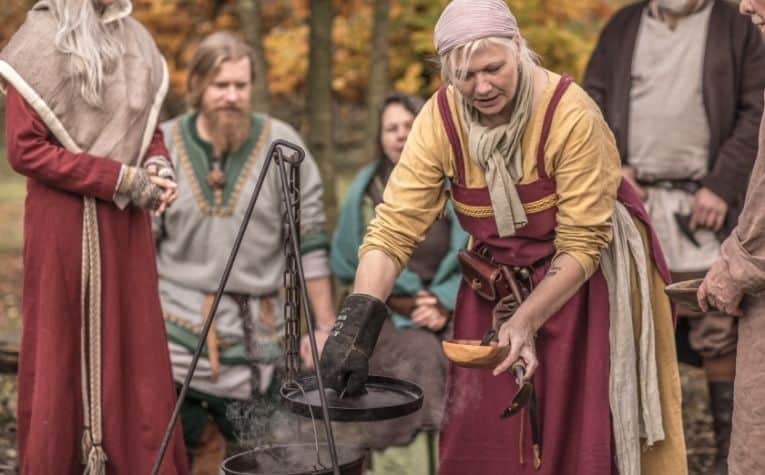In the vast timeline of history, the Viking Age was barely a blip. But for nearly two and a half centuries, the Vikings shaped and influenced life in Northern Europe and beyond.
Despite the common association with warfare and brutality, they were an enigmatic society with a complex belief system rooted in old Norse Mythology, marked by compelling narratives and filled with captivating characters.
Aside from worshipping Norse gods like Odin and Thor, the Vikings also believed in mythical creatures like trolls.
Not as feared as giants, trolls in Norse mythology and Viking folklore were dimwitted and mischievous and at worst, to be avoided at all costs if traveling alone in the woods.
The origin of trolls in Norse mythology and old Viking folklore is difficult to trace because the Vikings as a people group relied on oral traditions to pass down their stories and beliefs.
Old Scandinavian folktales used trolls to explain natural phenomena. They also played prominent roles in several Viking myths involving beloved Norse gods, including the great all-father Odin and the god of thunder, Thor.
The Vikings were religious people. See Why Did Vikings Worship Odin? to learn more.

The Vikings Believed in Trolls (and other Beings)
Unlike the followers of other religions of the Middle Ages, including Christianity, the Vikings’ believed in supernatural beings and mythical creatures as much as they worshipped and feared their Norse gods.
Their recognition of trolls as living entities in their universe went so far as accepting the very real possibility that trolls could meddle in their affairs and even pose a danger to their well-being or livelihood. [1]
The spread of Christianity is considered one of the factors that brought about the end of the Viking Age as more and more Vikings converted.
Interestingly, despite adopting the Christian faith, many Vikings held onto their ancestors’ old beliefs and mythologies and continued to pass down their old stories of mythical creatures like trolls, giants, and the like, all while considering themselves Christians. [2]
Trolls were so prominent in old Viking tales and lore that there were even, by some accounts, special amulets that were worn to ward off trolls specifically. [3]
What other creatures did the Vikings believe in? See What Dragons Meant to Vikings to learn more.
Trolls in Norse Mythology

Like the Jotnar (giants), trolls in Norse mythology were largely portrayed as the antagonists to Viking heroes like Thor, Odin, and other aesir gods.
And like giants, trolls were perceived by the Vikings as physically formidable beings who were capable of creating great havoc and destruction and inflicting unspeakable harm to those they victimized. They represented the chaos counterbalancing order in the world.
One of the most popular tales in Norse mythology is Thor’s epic battle with the great giant Hrungnir, whom he slew by hurling his hammer Mjolnir from a great distance away.
However, what set about this chain of events in motion was Odin’s boredom and yearning for the thrill of adventure while Thor was away in distant lands fighting and slaying trolls as he was often apt to do. [4]
Another mention of trolls comes as part of the Norse creation narrative.
As the gods were building the nine realms of the Viking universe, their homeland of Asgard was the first to be completed.
However, it lacked a wall to keep out the likes of trolls, giants, and other evildoers. Enclosures in Norse mythology symbolized the separation of good and evil. [5]
Trolls also made more than a few appearances in the Prose Edda, one of the few definitive written works about the Viking people and their way of life, where their disrepute was further cemented.
Christianity spread rapidly in Northern Europe at the end of the Viking era. See Were the Vikings Christian? to learn more.
What were Trolls like to the Vikings?

Although Viking descriptions of trolls varied as to their stature and appearance, most seem to be in agreement in portraying them as a humanoid with grossly distorted proportions and generally unsightly features.
However, they appear as colossal giant-like figures in some myths and legends, yet in others, they are more dwarf-like, barely rising to chest level compared to humans.
Regardless of their physical attributes, trolls were considered mischievous beings with evil streaks.
They reputedly robbed travelers of valuables and personal belongings in remote areas, and eating their victims was not out of the question.
On occasion, they could even mount attacks on unsuspecting farms and homesteads, pillaging and kidnapping in ways reminiscent of Viking warrior raids in Northern Europe.
As far as supernatural powers commonly attributed to trolls, these included:
- Superhuman strength – trolls were widely described as possessing physical strength that far exceeded humankind’s, to such extent that they were able to bear hug trees and rip them out of the ground and pick up large boulders and hurl them into the air like giant projectiles
- Powerful bond with nature – since they lived in the wild, often in caves and dark enclosed areas, trolls possessed a special bond with nature. They purportedly had the power to incite violent thunderstorms and even cause avalanches at will.
- Magical powers – other unique attributes reputedly possessed by trolls were magical powers such as the gift of illusion (making humans see treasure where there was none) and causing humans to fall asleep or lose track of time. Certain female trolls could cause men to fall into a trance with their sweet voices.
Unfortunately for trolls, there seems to be a general consensus that whatever attributes they had in abundance, namely brute strength and fearlessness, were drastically offset by a lack of intellect.
They were reputed to be slow and dimwitted, and thus, the surest way to emerge from an encounter with them unscathed was to outsmart them through deceit and trickery.
The Different Types of Scandinavian Trolls
Where the trolls of Norse mythology were considered vile enough to be worthy of Thor’s seemingly constant efforts to eradicate them, their counterparts in Scandinavian folklore were perhaps less deplorable and fearsome.
By some accounts, trolls could even reciprocate displays or acts of kindness directed toward them.
In fact, it is apparent that some of their despicable luster may have worn off in the stories and myths passed down by the people of certain parts of Scandinavia, namely Norway and Sweden, where tales of trolls were frequently told centuries ago and where trolls remain popular fantasy figures today. [6]
Norwegian Trolls
Throughout much of Norway’s history, including at the height of the Viking Age, its people believed in trolls and told old stories about them.
Trolls to the Norwegians were reclusive and lived in the wild, away from towns and villages.
Although not as nefarious as the trolls that battled with Thor in Norse myths, they were still creatures that were best to avoid for humans.
In Norway, they distinguished between two different types of trolls:
- Forest trolls – also referred to as mountain trolls, this breed of the troll was larger and stronger with many giant-like attributes. With the strength to uproot massive trees and swing them like clubs, forest trolls were a feared group for the sheer destruction they were capable of producing.
- Cave trolls were the smaller trolls who dwelled in caves or underground, had a bigger mischievous streak in them than their forest counterparts, and were more apt to deceive humans for their own gain.
Swedish Trolls
Like their Norwegian neighbors, the people of Sweden have long believed in trolls.
They too distinguished between the larger and uglier trolls that inhabited the forests and mountains that blanket much of Sweden and the smaller, elf-like trolls that lived below ground in caves and caverns.
The Swedes believed that trolls turned to stone when exposed to sunlight (hence their affinity for dark places), and this was their explanation for the presence of boulders throughout the Swedish wilderness.
Swedish folktales also told of trolls using boulders as weapons. [7]
Final Thoughts
The Viking universe was nothing if not enthralling, with figures and creatures that captured the imagination, and not to be excluded was the humble troll.
References:
[1] Live Science
[2] en.natmus.dk
[3] ancient.eu
[4] thenorsegods.com
[5] skjalden.com
[6] ancient origins
[7] blog.vkngjewelry.com
